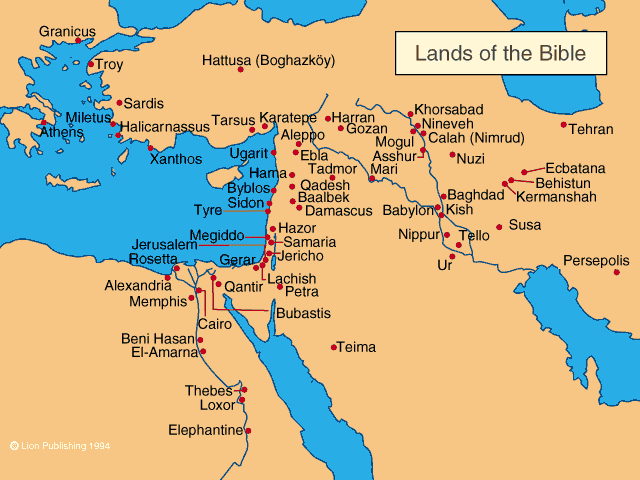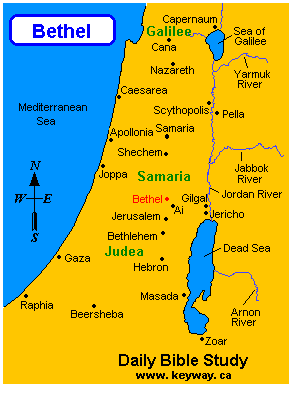3. Israel
The region between the Sinai
Peninsula and Lebanon, known by many names, as Israel,
Canaan, the Holy Land, Palestine, has no clear natural
frontiers. The River Jordan, rising in what is now
called Lebanon and flowing directly South, runs through the
middle, parallel to the Mediterranean coast, southward through
the lake called the Sea of Galilee (or Lake of
Gennesareth) and on down into the Dead Sea where its
waters evaporate, leaving the Dead Sea so charged with salts
that nothing can grow near it, whence its name. The Dead Sea is far
below sea-level.
Almost all the events of the Bible
stories happen in towns lying to the West, between the Jordan
and the sea. Jerusalem
lies west of the point where the Jordan enters the Dead Sea. The Bible stories
have two main centres, especially in New Testament times, one
the area around Jerusalem, called Judea or Judah, from
which comes the word "Jew", the other the area to the west of
the Sea of Galilee, called Galilee. Between these lies
the area called Samaria.
Most of the Holy Land is now rocky
and not very fertile, but in Bible times it seemed less arid
("a land flowing with milk and honey"). The Jordan is a small
river, of no importance for transportation though useful for
irrigation. Before the small groups of families (tribes)
calling themselves "the Children of Israel" took control of
the land, it was called Canaan and in recent times,
before the creation of the modern state of Israel, the
land was called Palestine. To the South stretches the
great desert of Sinai, between Israel and Egypt,
caught between the two branches of the Red Sea.
Early History: The Patriarchs
In the first book of the Bible, Genesis
(meaning beginning, origin), we see nomadic figures moving
across the empty spaces of the Middle East between Mesopotamia
and the Mediterranean regions.
Especially we see a particular family, with proper
names: Abraham, his son Isaac, his son Jacob
(who is also called Israel, whence the name of the
people "the children of Israel"). In the Bronze Age period between 2000
and 1500, semi-nomadic Amorites were coming down from
the Syrian deserts into the fertile lands of Canaan, as well
as across into Assyria.
Among them archaeologists have found names such as
Abram, Jacob, Levi, Benjamin.
Their flocks of sheep were their main wealth, but they
also had some interest in farming; this is the life-style of
the "patriarchs" (fathers).
These first fathers of the future tribes of Israel were
Arameans, people speaking various Semitic languages.
Movements of population brought
members of these "foreign" tribes down into Egypt,
where they took power as the Hyksos (foreign rulers),
and controlled Egypt from 1720-1580, when the Egyptians threw
them out and asserted their own power as far as the Euphrates. This control by
Egypt was reaffirmed by Rameses II around 1300, and
after a campaign in Canaan in about 1230, his successor could write
"Israel is laid waste", the first historical use of the
name in the sense of a place inhabited by a specific group of
people known as Israel.
Moses and the Exodus
After these victories, the Egyptians
used more and more Semitic slaves and prisoners-of-war in
their extensive new building projects, a kind of
sub-proletariate they called "apiru", a word also found
in Mesopotamia as "Habiru", meaning low-class
mercenaries or slaves from the poor nomads; it is probably the
origin of the word "Hebrew". The well-known
story of Moses (the name is Egyptian) who leads a group
of escaping Semitic slaves out of Egypt (Exodus) and
through the Sinai wilderness is rooted here. This group is shown
as united, although the people are of various family-origins,
by the action of a tribal god with the
four-consonant name יהוה YHWH (Yahweh-el), but the
name was rarely spoken, he was called Elohim, the Lord; the
familiar form "Jehovah" comes from a confusion, because the
Hebrew Old Testament writes the vowels for Elohim over the Tetragrammaton.
For the next two centuries this
original group of families, joined by others living in the
hills of Canaan who accepted the same faith, fought to
take control of the Canaanite villages in the fertile areas
near the Jordan. They were an amphictyony, a league
united by a conviction that the Lord had established a special
covenant with them. Here they found themselves
confronted with the Philistine problem. These were "People
of the Sea" whom Rameses III had driven out of Egypt and who
had settled on the coast of Canaan around 1150. They may have come
originally from Greece, their culture was partly Mycenaean,
and Homer mentions people with a similar name. They were stronger
than Israel, partly because they had learned to make iron
weapons, and in 1050 they defeated Israel and even captured
the Ark of the Covenant (a wooden box or throne
symbolizing the Lord's presence with Israel). The present name
"Palestine" is derived from "Philistine".
The Jerusalem Kingdom
About 1000 B.C., it became clear to
the religious leader (prophet) Samuel that the future
of the amphictyony was in danger and that a strong king
was needed to unite and lead the different families (tribes)
living in Canaan that considered themselves to have been
called by the Lord to take control of the land. The modern
state of Israel still
bases its existence on this notion of a Promised Land given
them by God. Until now there had been no social organization
beyond that of individual extended families, each with their
elder patriarch. Some
felt that the Lord was Israel's king and that no other leader
was needed.
After a first attempt with Saul
that failed, in about 1012 David became the new
king, first in the South, where he crushed the Philistines. He was accepted by
the remaining Canaanite populations, and imposed his rule so
strongly that the surrounding peoples recognized his
control over the whole land.
Finally, he made the Canaanite city of Jerusalem
his new capital, the centre of the Covenant, and so unifying the
various groups and
tribes. David's forty years of kingship (1012 - 972)
were partly inspired by the forms of divine kingship found in
Mesopotamia, adapted to Israel's unique vision of a God who
saves in history through his anointed
servants.
David's son, Solomon, (ruled
972 - 931) made Israel part of the Mediterranean world by
joining forces with the Phoenicians in commerce, by
adopting much of their culture and by building a Temple
at Jerusalem in Canaanite style, using Phoenician building
techniques. Solomon's
court was extremely sophisticated artistically and
culturally. In
this time orders were given to record in writing all the stories
of Israel's origins that until then had only been transmitted
orally, the writing of the Bible had begun. Some of the
earliest texts in Genesis were written at this time,
including the familiar story of Paradise, the Temptation of
Eve by the serpent, and the Fall, by an individual writer
often known as the Yahwist. All animal sacrifices were
forbidden outside the new Jerusalem Temple, as well, so
centralizing the religious life.
After Solomon died, however, the
nation divided, there was much conflict and the tribes of the
North established the Kingdom of Israel centered on
the city of Samaria, while those of the South
continued in Jerusalem, the centre of the Kingdom of Judah. In 722, the Assyrians
destroyed Samaria (and Damascus in Syria), and deported the
people; the Northern Kingdom ceased to exist.
Exile and Return
For one thousand years, after
Hammurabi had consolidated the unity of the Assyrian Empire, the main
concern had been survival in a way of life close to that found
in the Bible stories about Abraham and the patriarchs. Then, after the
year 900, new energy brings the Assyrians into the Bible
stories of the history of Judah, with wars and treaties
involving kings such as Sennacherib (705-681).
Babylon was burned in 648, in
response to a regionalistic uprising against the Assyrian
kings, so the local citizens called in the Medes (who
were Indo-Europeans) and in 612 Nineveh fell to the
new dynasty. Under
Nebuchadrezzar II (605-561) there was war with Egypt
and invasion of Palestine.
In 598 the people around Jerusalem (Judah)
rebelled, the king and 3000
citizens were taken back to Mesopotamia. When the survivors
rebelled again in 589, Nebuchadrezzar (also known as Nebuchadnezzar,
reigned 605 - 561) destroyed Jerusalem after a siege which
lasted until 587.
This marks
the beginning of the Exile, a vital time in Israel's
history, for the Jewish exiles were not dispersed among the
population of Mesopotamia; they continued to live close
together. Their
special religion served as a uniting force, and while studying
the written "scriptures" (writings) they had brought with them,
rewriting other records, and so composing the core of the Jewish
Bible (called the Old Testament by Christians) they waited for the
Lord of their past history to save them as he had saved their
forefathers from Egypt. Since the Lord had always acted in
history through human agents, and not by some kind of divine
intervention, it was no great surprise when the long-awaited
liberation from Exile and return to Jerusalem came from the
Persian king Cyrus in 536, after his conquest of
Babylon.
There they rebuilt the
Jerusalem Temple, which was rededicated in 516. Only later, around
445, did they rebuild the city walls. Almost two generations had lived and died
away from the "Holy Land", yet they had forgotten nothing of
their faith. This
miraculous return from Exile and apparent disaster did not mean
that Judah was able to become an independent state. Like Egypt,
it remained part of the Persian zone of influence until
the campaigns of Alexander the Great changed the face of
the region. After that, the Jews were ruled by either the
Ptolemies of Egypt or the Seleucids in Syrian Antioch.

